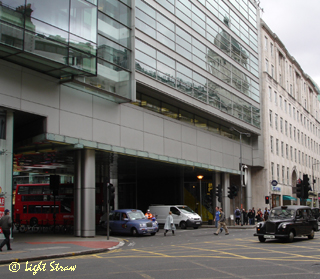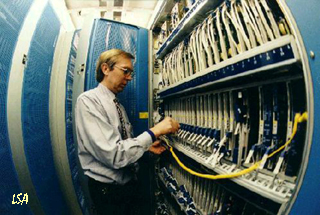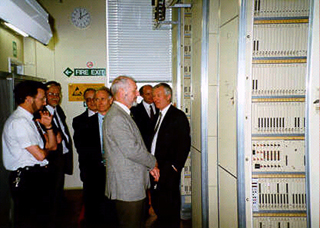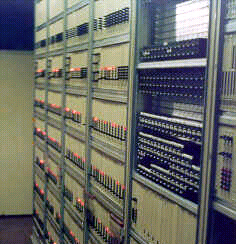 |
In the evolution of telephone switching the TXE, or Telephone eXchange Electronic, used common control for call set up with solid-state (no moving parts) processors. |
History of TXE4
The TXE4
Following public trials in 1969 the Telephone eXchange Electronic No.4 went into production with STC in 1971.
TXE4RD
The first TXE4RD (Rectory Design) exchange opened in Birmingham in February 1976 and was to become the standard for all large electronic exchanges.
TXE4A
Was a much developed, cost reduced version using large scale integration to replace the threaded-wire stores of the TXE4RD. The first TXE4A went into public service in Belgrave, Leicester on 28th February 1981. Some TXE4RD sites were extended by adding a TXE4A unit.
TXE4(E)
This (E)nhanced version of the TXE4RD, allowed facilities such as Call Logging and Common Channel Signalling and abolished the need for the mechanical subscribers' meters, which had always seemed rather dated in a 'modern' electronic exchange. All TXE4s were progressively given this upgrade from 1987 onwards.
GRS
The Gate Replacement System was the final major change to the TXE4s. This replaced the threaded wire stores (Cyclic Stores Gates), which were used to indicate class of service etc., with an electronic equivalent, thus enabling keyboard programming of new lines and TOS-ing of existing lines remotely. The GRS was applied to all remaining TXE4s between 1990 and 1991.
The End
It was always envisaged that the TXE4s would continue their useful life into the year 2000 and beyond. However, once all of the Strowger and TXE2 exchanges had been replaced ahead of schedule, the TXE4 was fast becoming an expensive liability in comparison with the new facilities (such as Call Return 1471) that the digital exchanges could offer and customers expected to be available.
It's somewhat ironic that customers whose exchange was converted in the 'early days' from Strowger to TXE4 had to wait far longer for 'up to date facilities' than those that went straight from Strowger to X or Y, as the conversion programme gathered pace. As a stop-gap measure, TXE4 subs. could be co-located onto a digital overlay unit to give them features such as call diversion which although possible on TXE4 may have been difficult to administer. [Call diversion for 'own exchange' calls was available, but national call diversion would have necessitated a new standard of inter-exchange signalling for the TXE4, hence the facility was not marketed].
During 1997, BT's exchange modernisation programme was finalised and a plan was devised to replace all the remaining TXE4 exchanges throughout the country.
By 10th March 1998, there were only 2 TXE4 exchanges still to be converted. These were carefully scheduled so that one would be replaced by System X and the other by System Y.
An Analogue ExchangeProcter House
 |
Procter House was the home of the TXE4 development team throughout the 1970s and 80s. |
| The Last Two TXE4s | |
 |
In a simultaneous change-over, the last two TXE4s, in Selby, North Yorkshire and Leigh-on-Sea, in Essex, were taken out of service at 06.00hrs on Wednesday 11th March 1998. |
| The Reunion | |
 |
The Digital switchover was attended by the original members of the TXE4 Development Team who had been especially invited to the Leigh-on-Sea ceremony. |
Page last updated 15th May 2012. Checked May 2021.
All logos and trade marks are the property of their respective owners and are used on the Light Straw site(s) for review only. Students and researchers are recommended to make their own independent enquiries as to the accuracy of the information contained therein.
